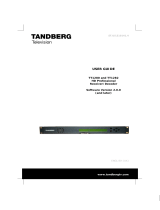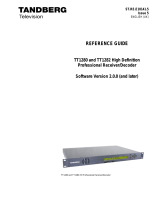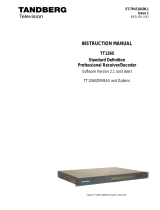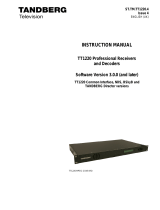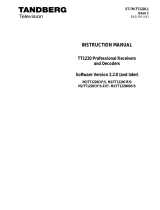Page is loading ...

ST.RE.TT1222.2
Issue 2
ENGLISH (UK)
REFERENCE GUIDE
TT1222 4:2:0
Professional Receiver
Software Version 2.0.0 (and later)
TT1222 4:2:0 Professional Receiver

Preliminary Pages
Page ii Reference Guide: TT1222 4:2:0 Professional Receiver
ST.RE.TT1222.2
Issue 2 first published in 2005 by:
T
ANDBERG TELEVISION LTD
R
EGISTERED ADDRESS:
U
NIT 2 STRATEGIC PARK, COMINES WAY,
H
EDGE END, SOUTHAMPTON,
H
AMPSHIRE,
SO30 4DA
U
NITED KINGDOM
Registered Company Number 03695535
This document and the information contained in it is the property
of TANDBERG Television Ltd and may be the subject of patents
pending and granted. It must not be used for commercial
purposes nor copied, disclosed, reproduced, stored in a retrieval
system or transmitted in any form or by any means (electronic,
mechanical, photocopying, recording or otherwise), whether in
whole or in part, without TANDBERG Television’s prior written
agreement.
2005 TANDBERG Television Ltd. All ri
g
hts reserved.
SVENSKA
LÄS DETTA FÖRST!
Om Ni inte förstår informationen i denna handbok
ARBETA DÅ INTE MED DENNA UTRUSTNING.
En översättning till detta språk av denna handbok kan också anskaffas,
på Er bekostnad.
ENGLISH (UK)
READ THIS FIRST!
If you do not understand the contents of this manual
DO NOT OPERATE THIS EQUIPMENT.
Also, translation into any EC official language of this manual can be
made available, at your cost.
ΕΛΛΗΝΙΚΑ
∆ΙΑΒΑΣΤΕ ΠΡΩΤΑ ΑΥΤΟ!
Αν δεν καταλάβετε το περιεχόµενο αυτού του βοηθήµατος/εγχειριδίου
ΜΗΝ ΛΕΙΤΟΥΡΓΗΣΕΤΕ ΑΥΤΟΝ ΤΟΝ ΕΞΟΠΛΙΣΜΟ.
Επίσης, αυτό το εγχειρίδιο είναι διαθέσιµο σε µετάφραση
σε αυτή τη γλώσσα και µπορείτε να το αγοράσετε.
DEUTSCH
LESEN SIE ZUERST DIESEN HINWEIS!
Sollte Ihnen der Inhalf dieses Handbuches nicht klar verständlich sein,
dann
BEDIENEN SIE DIESE GERÄTE NICHT!
Eine Übersetzung des Handbuches in diese Sprache ist gegen
Berechnun
g
lieferbar.
ESPAÑOL
LEA ESTE AVISO PRIMERO!
Si no entiende el contenido de este manual
NO OPERE ESTE EQUIPO.
Podemos asimismo suministrarle una traducción de este manual al
(idioma) previo pago de una cantidad adicional que deberá abonar
usted mismo.
FRANÇAIS
AVANT TOUT, LISEZ CE QUI SUIT!
Si vous ne comprenez pas les instructions contenues dans ce manuel
NE FAITES PAS FONCTIONNER CET APPAREIL.
En outre, nous pouvons vous proposer, à vos frais, une version
française de ce manuel.
ITALIANO
LEGGERE QUESTO AVVISO PER PRIMO!
Se non si capisce il contenuto del presente manuale
NON UTILIZZARE L’APPARECCHIATURA.
È anche disponibile la versione italiana di questo manuale, ma il costo è
a carico dell’utente.
PORTUGUÊS
LEIA O TEXTO ABAIXO ANTES DE MAIS NADA!
Se não compreende o texto deste manual
NÃO UTILIZE O EQUIPAMENTO.
O utilizador poderá também obter uma tradução do manual para o
português à própria custa.
NEDERLANDS
LEES DIT EERST!
Als u de inhoud van deze handleiding niet begrijpt
STEL DEZE APPARATUUR DAN NIET IN WERKING.
U kunt tevens, op eigen kosten, een vertaling van deze handleiding
krijgen.
DANSK
LÆS DETTE FØRST!
Udstyret må ikke betjenes
MEDMINDRE DE TIL FULDE FORSTÅR INDHOLDET AF DENNE
HÅNDBOG.
Vi kan også for Deres regning levere en dansk oversættelse af denne
håndbog.
SUOMI
LUE ENNEN KÄYTTÖÄ!
Jos et ymmärrä käsikirjan sisältöä
ÄLÄ KÄYTÄ LAITETTA.
Käsikirja voidaan myös suomentaa asiakkaan kustannuksella.

Preliminary Pages
Reference Guide: TT1222 4:2:0 Professional Receiver Page iii
ST.RE.TT1222.2
List of Contents
Chapter 1: Introduction
This chapter describes the purpose of the TT1222 in a typical system,
provides a summary of its main features and identifies the controls.
Chapter 2: Installing the Equipment
This chapter provides a guide to installing the equipment, including the
suitability of an installation, detailed procedures for the preparation,
installation and configuration. This chapter also includes important
safety information. It also lists the pin-outs for the various connectors,
and details the power cycle procedure.
Chapter 3: Options and Upgrades
This chapter describes the options and upgrades available for the
TT1222 4:2:0 Professional Receiver.
Chapter 4 Operating the Equipment Locally
This chapter provides a guide to using the LCD interface and keypad. It
also details the setting up, configuration and operating procedures.
Chapter 5: Operating the Equipment Remotely
This chapter provides a guide to configuring the RS-232 remote control
port, and preparing the unit for remote operation. This chapter does not
detail the remote control procedure itself, as this is detailed in the
instructions for the individual control system.
Chapter 6: Alarms/GPOs
This chapter provides a guide to configuring the alarm interface and
menus.
Chapter 7: Preventive Maintenance and Fault-Finding
This chapter details routine maintenance tasks to be performed, provides
general service advice, and information regarding warranty.
Annex A: Glossary
Annex B: Technical Specification
Annex C: Front Panel LCD Menus
Annex D: Alarm Categories and Conditions

Preliminary Pages
Page iv Reference Guide: TT1222 4:2:0 Professional Receiver
ST.RE.TT1222.2
About This Reference Guide
This Reference Guide provides instructions and information for the
installation and operation of the TT1222 4:2:0 Professional Receiver.
It should be kept in a safe place for reference for the life of the equipment.
It is not intended that this Reference Guide is amended by the issue of
individual pages. Any revision will be by a complete reissue. Further copies
of this Reference Guide can be ordered from the address shown on
page vii. If passing the equipment to a third party, also pass on the
relevant documentation.
Issues of this Reference Guide are listed below:
Issue Date Software Version Comments
1 Feb 2005 1.0.0 Initial release.
2 Apr 2005 2.0.0
Minor corrections. Changes to Menus. Addition of Russian
SECAM Out option module.
The following documents are also associated with this equipment:
• ST.US.TT1222: TT1222 Professional Receiver User Guide
Acknowledgements
General
All best endeavours have been made to acknowledge registered
trademarks and trademarks used throughout this Reference Guide. Any
notified omissions will be rectified in the next issue of this Reference
Guide. Some trademarks may be registered in some countries but not in
others.
Registered trademarks and trademarks used are acknowledged below and
marked with their respective symbols. However, they are not marked
within the text of this Reference Guide.
Registered Trademarks
AC-3
®
, Dolby Digital
®
and Pro Logic
®
are registered trademarks of Dolby
Laboratories Licensing Corporation.
Musicam
®
is a registered trademark of Thomson and Télédiffusion de
France (TDF), Europe and is a registered trademark of CCS (now Musicam
USA Incorporated), USA.
Ethernet
®
is a registered trademark of Xerox Corporation.
VideoGuard
®
is a registered trademark of NDS Limited.
Macrovision
This product incorporates copyright protection technology that is protected
by U.S. patents and other intellectual property rights. Use of this copyright
protection technology must be authorized by Macrovision Corporation, and
is intended for home and other limited viewing uses only unless authorized
by Macrovision. Reverse engineering or disassembly is prohibited.

Preliminary Pages
Reference Guide: TT1222 4:2:0 Professional Receiver Page v
ST.RE.TT1222.2
Warnings, Cautions and Notes
Heed Warnings
All warnings on the product and in the operating instructions should be
adhered to. The manufacturer cannot be held responsible for injuries or
damage where warnings and cautions have been ignored or taken lightly.
Read Instructions
All the safety and operating instructions should be read before this product
is operated.
Follow Instructions
All operating and use instructions should be followed.
Retain Instructions
The safety and operating instructions should be retained for future
reference.
WARNINGS…
WARNINGS GIVE INFORMATION WHICH, IF STRICTLY OBSERVED, WILL PREVENT PERSONAL
INJURY OR DEATH, OR DAMAGE TO PERSONAL PROPERTY OR THE ENVIRONMENT. THEY
ARE BOXED AND SHADED FOR EMPHASIS, AS IN THIS EXAMPLE, AND ARE PLACED
IMMEDIATELY PRECEDING THE POINT AT WHICH THE READER REQUIRES THEM.
CAUTIONS...
Cautions give information which, if strictly followed, will prevent damage to equipment or other goods.
They are boxed for emphasis, as in this example, and are placed immediately preceding the point at
which the reader requires them.
NOTES...
Notes provide supplementary information. They are highlighted for emphasis, as in this example, and
are placed immediately after the relevant text.
EMC Compliance
This equipment is certified to the EMC requirements detailed in Annex B,
Technical Specification. To maintain this certification, only use the leads
supplied or if in doubt contact Customer Services.

Preliminary Pages
Page vi Reference Guide: TT1222 4:2:0 Professional Receiver
ST.RE.TT1222.2
TANDBERG Television Customer Services
Support Services
Our primary objective is to provide first class customer care that is tailored
to your specific business and operational requirements. All levels are
supported by one or more service performance reviews to ensure the
perfect partnership between TANDBERG Television and your business.
Warranty
All TANDBERG Products and Systems are designed and built to the highest
standards and are covered under a comprehensive 12 month warranty.
Levels of Continuing TANDBERG Television Service Support
For stand-alone equipment, then TANDBERG Television BASIC
Advantage is the value for money choice for you. BASIC provides you
with year-by-year Service long after the warranty has expired.
For systems support you can choose either Gold or Silver Advantage.
These packages are designed to save you costs and protect your income
through enlisting the help of TANDBERG Television support specialists.
Call TANDBERG Sales for more details.
Where to Find Us
Europe, Middle East +44 (0) 23 8048 4455
and Africa: Fax: +44 (0) 23 8048 4467
Americas: +1 (321) 308 0470
China: +86 10 6856 0260 (Beijing)
+852 2530 3215 (Hong Kong)
Australia/NZ: +612 8923 0450
Internet Address: http://www.tandbergtv.com

Preliminary Pages
Reference Guide: TT1222 4:2:0 Professional Receiver Page vii
ST.RE.TT1222.2
Technical Training
Training Courses
TANDBERG Television provides a wide range of training courses on the
operation and maintenance of our products and on their supporting
technologies. TANDBERG can provide both regularly scheduled courses and
training tailored to individual needs. Courses can be run either at your
premises or at one of our dedicated training facilities.
Where to Find Us
For further information on TANDBERG Television's training programme
please contact us:
International Telephone: +44 23 8048 4229
International Facsimile +44 23 8048 4467
E-mail Address: [email protected]
Internet Address http://www.tandbergtv.com
Customer Services and Technical Training Postal Address
Tandberg Television
Unit 2
Strategic Park
Comines Way
Hedge End
Southampton
Hampshire
SO30 4DA
United Kingdom
Return of Equipment
If you need to return equipment for repair, please contact the Customer
Services Helpdesk on +44 (0) 23 8048 4455. A Returns Authorisation
Number (RAN) will be issued and full details of the unit will be logged.
Please ensure the RAN number is clearly marked on the packaging of the
unit. The unit should then be sent to the following address:
Tandberg Television – Customer Services
Unit 1
Strategic Park
Comines Way
Hedge End
Southampton
Hampshire
SO30 4DA
United Kingdom
Technical Publications
If you need to contact TANDBERG Television Technical Publications
regarding this publication, e-mail: techpub[email protected].

Preliminary Pages
Page viii Reference Guide: TT1222 4:2:0 Professional Receiver
ST.RE.TT1222.2
BLANK

Reference Guide: TT1222 4:2:0 Professional Receiver Page 1-1
ST.RE.TT1222.2
Chapter 1
1. Introduction
Contents
1.1 Scope of This Reference Guide................................1-3
1.1.1 Who Should Use This Reference Guide.......1-3
1.1.2 What Equipment is Covered by This
Reference Guide ..........................................1-3
1.1.3 Software Version..........................................1-3
1.2 Summary of Features................................................1-4
1.2.1 Main Features...............................................1-4
1.2.2 Outputs.........................................................1-5
Video Outputs...............................................1-5
Audio Outputs...............................................1-5
Data Output..................................................1-5
Relay / GPO Output......................................1-5
ASI Output (Option)......................................1-5
1.2.3 Conditional Access.......................................1-6
1.3 TT1222 Control Modes.............................................1-6
1.3.1 Introduction...................................................1-6
1.3.2 Remote Control ............................................1-6
1.3.3 Local Control ................................................1-6
1.4 Guided Tour..............................................................1-7
1.4.1 Construction .................................................1-7
1.4.2 Front Panel Controls.....................................1-7
Overview.......................................................1-7
Edit and Save...............................................1-8
Cancel an Edit..............................................1-8
1.4.3 Front Panel LED...........................................1-8
1.4.4 Conditional Access – DVB Common
Interface........................................................1-8
1.4.5 Rear Panel....................................................1-8
List of Figures
Figure 1.1: Front View...................................................................1-3
Figure 1.2: Navigating the Menus..................................................1-7
Figure 1.3: Editing Values in a Menu............................................. 1-7
List of Tables
Table 1.1: Equipment Model Descriptions.....................................1-3

Introduction
Page 1-2 Reference Guide: TT1222 4:2:0 Professional Receiver
ST.RE.TT1222.2
BLANK

Introduction
Reference Guide: TT1222 4:2:0 Professional Receiver Page 1-3
ST.RE.TT1222.2
1.1 Scope of This Reference Guide
1.1.1 Who Should Use This Reference Guide
This Reference Guide is written for operators/users of the TANDBERG
TT1222 Professional Receiver. It describes the unit’s functions and
operation. The Reference Guide is written to assist in the installation and
day-to-day care and operation of the unit. It does not include any
maintenance information or procedures which would require the removal
of covers.
WARNING…
DO NOT REMOVE THE COVERS OF THIS EQUIPMENT. HAZARDOUS VOLTAGES ARE PRESENT
WITHIN THIS EQUIPMENT AND MAY BE EXPOSED IF THE COVERS ARE REMOVED. ONLY
TANDBERG TELEVISION TRAINED AND APPROVED SERVICE ENGINEERS ARE PERMITTED TO
SERVICE THIS EQUIPMENT.
CAUTION…
Unauthorised maintenance or the use of non-approved replacements may affect the equipment
specification and invalidate any warranties.
1.1.2 What Equipment is Covered by This Reference Guide
The base model of the TT1222 Receiver comprises of an enclosure and
Base Board only.
Figure 1.1: Front View
There are a number of option modules which can be added to the base
unit to provide additional inputs and outputs. Information regarding the
option modules can be found in Chapter 3, Options.
Table 1.1: Equipment Model Descriptions
Model Number Marketing Code Description
TT1222 Receiver TT1222/CIBAS
Professional Receiver. 1U MPEG-2 4:2:0 Receiver.
Common Interface CA unit with: 2 x Composite Video Outputs, 2 x Audio
Outputs, RS-232 Data, RS-232 Remote Control, 5 x General Purpose
Outputs (GPO), 1 x Alarm Relay and 1 x Ethernet Port (for future use)
1.1.3 Software Version
This Reference Guide has been written to cover the functionality of
software version 2.0.0 (and later). The current software version can be
found in the Properties Menu.

Introduction
Page 1-4 Reference Guide: TT1222 4:2:0 Professional Receiver
ST.RE.TT1222.2
1.2 Summary of Features
1.2.1 Main Features
The Receiver is fully compliant with the appropriate sections of the
MPEG-2
1
and DVB-S
2
specifications.
The TT1222 offers the following features:
• Signal Inputs:
QPSK L-Band (Option)
3
- 1 x QPSK via F-connector
ASI input (Option)
3
- 1 x ASI via BNC connector
• Signal Outputs:
Composite Video Outputs - 2 x CVBS via BNC connectors
Audio outputs - 2 x Audio via 9-way D-Type
connectors (Analogue and Digital)
ASI output
(Option)
3
- 1 x ASI via BNC connector
• Video Decoding:
4:2:0 MP@ML mode support video resolutions up to 720 pixels x
576 active lines (25 frame/s) or 720 pixels x 480 active lines
(30 frame/s)
No 4:2:2 support
Support for PAL- (B, D, G, H, I, M and Combination N)
Support for SECAM (B, G, H, K1, L) Line ID
Support for SECAM (D, K) Field ID (Option)
3
Support for NTSC (M)
• Audio Decoding:
Decoding of two separate audio services. (Audio 1 is dependent on
the TV service selection. Audio 2 audio is individually configured).
Support of MPEG-1 Layer I and II (Musicam)
Support of Dolby Digital AC-3 downmix
Sampling rates 32, 44.1 and 48 kHz
All MPEG-1 Layer I and II bit-rates
• Vertical Blanking Interval (VBI) Signalling Support:
In 625 lines: VITS test lines, WSS, WSS-AFD, VPS, WST (EBU)
Teletext insertion and Inverted Teletext is supported in the
analogue video output.
In 525 lines: VITS test lines, Closed Captions and V.Chip signalling
are supported in the analogue video output.
• Service Selection:
Chosen from a menu list of available services carried in the
currently received transport stream in PSI/SI enabled mode.
• Conditional Access:
DVB Common Interface
1
Moving Pictures Expert Group: MPEG-2 specification ISO 13818.
2
European Digital Video Broadcasting (DVB) Project. EN 300 421 Digital broadcasting systems for television, sound
and data services: Framing structure, channel coding, and modulation for the 11/12 GHz satellite service.
3
See Chapter 3 for details of options.

Introduction
Reference Guide: TT1222 4:2:0 Professional Receiver Page 1-5
ST.RE.TT1222.2
BISS Modes 1 and E
• Front Panel Controls and Indications:
A 2 row by 20 character back lit LCD display provides information
and allows operator choice entry
Four pushbuttons provide the control interface in conjunction with
the LCD display
Single LED provides status information
• Data:
Low speed data: RS-232 asynchronous (up to 115.2 kbit/s)
• Remote Control:
RS-232, TANDBERG proprietary control solution
• Control
1 Relay available
5 General Purpose Outputs
1.2.2 Outputs
Video Outputs
Two BNC composite video outputs are present on the rear of the unit.
Audio Outputs
There are two audio outputs available on 9-way D-sub connectors at the
rear panel. Each connector provides one balanced analogue audio pair and
one unbalanced digital signal. Dependent on the input, the user can
configure the analogue output to present the audio as one stereo, a dual-
mono or two independent mono channels.
Data Output
RS-232 asynchronous low speed data output carried on a 9-way D-sub
connector, available on all models. The data output rate is configurable
from 75 bit/s to 115200 bit/s.
Relay / GPO Output
The unit can be set up to produce warnings and alarms when particular
conditions occur.
The relay output can be set up to trigger on one or more ‘error’ states.
When the equipment has detected an error, the relay is triggered and the
front panel alarm LED is also activated. For instructions on configuring the
alarms, see Chapter 6, Alarms/GPOs. For a description of the alarm relay,
see Chapter 2, Installing the Equipment.
The same connector supports five GPOs (General Purpose Outputs). These
can be set up to trigger on a single or numerous events. These signals are
independent of the relay signal.
ASI Output (Option)
A single ASI output is available if the hardware option
TT1222/HWO/ASI/OUT is purchased.
More detail on the option modules can be found in Chapter 3, Options.

Introduction
Page 1-6 Reference Guide: TT1222 4:2:0 Professional Receiver
ST.RE.TT1222.2
1.2.3 Conditional Access
The transport stream received by the IRD may be encrypted. The CA
system is used to decrypt the required components of the transport
stream so that they can be decoded.
The following conditional access system is available on the TT1222
Receiver.
• DVB Common Interface
• BISS Modes 1 and E
1.3 TT1222 Control Modes
1.3.1 Introduction
The TT1222 is designed for unattended operation. Once set up, it requires
no further attention except to ensure that the fan is working. There are
two control modes associated with the Receiver, local (keypad), and
remote (RS-232) control.
1.3.2 Remote Control
This state is entered when the Ctrl Mode setting in the Setup:Control
menu is set to remote. When the Decoder is remotely controlled, local
control is disabled until the Decoder is configured for the local mode.
1.3.3 Local Control
Local control allows parameters to be entered and chosen using the four
arrow keys.
The arrow keys roles and functions change, depending on what kind of
menu or screen is available at the moment.
The Up/Down arrow keys are used for previous/next item in a menu,
previous/next option in an option select menu (for instance, on or off) or
the higher/lower digit in a numerical entry menu.
The Right/Left arrow keys are used to enter/leave a menu or submenu,
and to select the next or previous digit in a numerical entry menu.

Introduction
Reference Guide: TT1222 4:2:0 Professional Receiver Page 1-7
ST.RE.TT1222.2
1.4 Guided Tour
1.4.1 Construction
The Receiver is constructed using a screened fan-ventilated chassis. All
operational inputs and outputs are via the rear panel connectors. The unit
may be operated freestanding on a horizontal flat surface, or mounted in a
19-inch rack. 1RU rack height is required. It is important that horizontal
airflow is not obstructed, to maintain the airflow required to cool the unit.
1.4.2 Front Panel Controls
Overview
The front panel is fitted with a keypad that is used to set up and monitor
the unit. Information on the use of these controls is given in Chapter 4,
Operating the Equipment Locally. It gives an overview on how to navigate
the menus. Figure 1.3 explains how to edit these values once a menu item
is selected.
Figure 1.2: Navigating the Menus
Figure 1.3: Editing Values in a Menu.
Move cursor down /
scroll down
Select item at cursor
Move cursor up /
scroll up
Return to previous
menu
Increment value
Decrement value
Position Cursor
Position Cursor

Introduction
Page 1-8 Reference Guide: TT1222 4:2:0 Professional Receiver
ST.RE.TT1222.2
Edit and Save
In the edit mode, when the correct value is in place, exit and save by
pressing multiple times to the right, to move the cursor outside the edit
area. When the cursor leaves the edit area, the new setting will be saved,
and the keypad will revert to the navigation mode.
Cancel an Edit
In the edit mode, if you have incorrectly entered a value, cancel and exit
by pressing multiple times to the left, to move the cursor outside the edit
area. When the cursor leaves the edit area, the previous setting will
reappear, and the keypad will revert to the navigation mode.
NOTE…
Keypad access may be locked, easily recognised by the small lock in the top left corner of the display.
To navigate the menus, escape the locked mode by pressing left, right, 3 x left and then 3 x right in
sequence. This will take you from the default status screen, to the main menu.
1.4.3 Front Panel LED
The unit is fitted with one LED, showing the status of the unit. When the
LED lights up red, an alarm condition has been met, according to the
alarm set-up described in Annex D, Alarm Categories and Conditions.
1.4.4 Conditional Access – DVB Common Interface
There is one slot on the rear of the unit, to allow the insertion of a DVB
Common Interface Module.
1.4.5 Rear Panel
All input and output connectors are located on the rear panel. Connector
descriptions are given in Chapter 2, Installing the Equipment.

Reference Guide: TT1222 4:2:0 Professional Receiver Page 2-1
ST.RE.TT1222.2
Chapter 2
2. Installing the Equipment
Contents
2.1 Read this First!..........................................................2-3
2.1.1 Handling .......................................................2-3
2.1.2 Installing the Equipment...............................2-3
2.1.3 Lifting............................................................2-3
2.1.4 Site Requirements........................................2-3
Power Supplies.............................................2-3
Environment .................................................2-3
Lightning Protection......................................2-3
2.2 Preliminary Checks...................................................2-4
2.2.1 Mechanical Inspection..................................2-4
2.2.2 Moving the Equipment Safely.......................2-4
2.3 Installing the Equipment............................................2-4
2.3.1 Fixing............................................................2-4
2.3.2 Ventilation.....................................................2-4
Openings in the Covers................................2-4
Care in Positioning .......................................2-5
Protection From Moisture.............................2-5
2.3.3 Installing Cables – Safety.............................2-5
2.4 EMC Compliance Statements...................................2-6
2.4.1 EN 55022 and AS/NZS 3548........................2-6
2.4.2 FCC..............................................................2-6
2.4.3 Connecting to a Public
Telecommunication System .........................2-6
2.5 AC Supply Voltage and Fusing – Safety
Information................................................................2-6
2.5.1 AC Power Supply .........................................2-6
2.5.2 Technical Earth.............................................2-7
2.5.3 AC Power Supply Cord.................................2-7
General.........................................................2-7
Disposal of Moulded Plugs...........................2-8
Wire Colours.................................................2-8
2.5.4 Connecting the Equipment to the AC
Power Supply................................................2-8
2.6 Signal Connections....................................................2-9
2.6.1 Overview.......................................................2-9
2.6.2 Input Connectors...........................................2-9
QPSK Input (TT1222/HWO/QPSK)...............2-9
ASI Input (TT1222/HWO/ASI/IN)................2-10
RS232 Remote............................................2-10
2.6.3 Output Connectors......................................2-10
Analogue Video Outputs.............................2-10
Analogue/Digital Audio Outputs..................2-11
Audio Lead..................................................2-12
ASI Output (TT1222/HWO/ASI/OUT)..........2-12
RS-232 Low-speed Asynchronous Data
Output.........................................................2-12
Alarm Relay/General Purpose Output.........2-13
2.6.4 RS232 Remote............................................2-14
2.6.5 Conditional Access Interface ......................2-14
List of Figures
Figure 2.1: Openings in the Cabinet..............................................2-4
Figure 2.2: Technical Earth Connector.......................................... 2-7
Figure 2.3: Signal Connections .....................................................2-9
Figure 2.4: Example Rear Panel View (Model fitted with
QPSK Option)...............................................................2-9
Figure 2.5: Audio Cable...............................................................2-12
List of Tables
Table 2.1: Supply Cord Wiring Colours......................................... 2-8
Table 2.2: Non Standard Supply Cord Wire Colours.....................2-8
Table 2.3: RS-232 Connector......................................................2-10
Table 2.4: Analogue Video Connector.........................................2-11
Table 2.5: Audio Connectors 1 and 2..........................................2-11
Table 2.6: RS-232 Low-speed Data Connector ..........................2-13
Table 2.7: Relay/GPO Pin Allocation...........................................2-13

Installing the Equipment
Reference Guide: TT1222 4:2:0 Professional Receiver Page 2-3
ST.RE.TT1222.2
2.1 Read this First!
2.1.1 Handling
The TT1222 must be handled and installed carefully and thoughtfully to
prevent safety hazards and damage.
2.1.2 Installing the Equipment
Follow the instructions for installation and only use installation accessories
recommended by the manufacturers.
Ensure that personnel designated to install the unit have the appropriate
skill and knowledge. If in any doubt, please contact Customer Services
(see Preliminary pages for contact details).
When rack mounted, this unit must have shelf supports as well as being
fixed at the front panel. Do not use this product as a support for any other
equipment.
2.1.3 Lifting
Although this is a light product, in some circumstances it might be
awkward to lift, especially when packed. In which case, do not attempt to
lift or move it without proper assistance or equipment. If in doubt, get
help.
2.1.4 Site Requirements
Power Supplies
See Annex B, Technical Specification for a full specification.
Environment
See Annex B, Technical Specification for a full specification.
Do not install this product in areas of high humidity or where there is
danger of water ingress.
Lightning Protection
WARNING…
IF THE UNIT HAS BEEN SUBJECT TO A LIGHTNING STRIKE OR POWER SURGE WHICH HAS
STOPPED IT WORKING, DISCONNECT THE POWER IMMEDIATELY. DO NOT REAPPLY POWER
UNTIL IT HAS BEEN CHECKED FOR SAFETY. IF IN DOUBT, CONTACT TANDBERG TELEVISION
CUSTOMER SERVICES.
Where appropriate, ensure this product has an adequate level of lightning
protection. Alternatively, during a lightning storm or when it is left
unattended and unused for long periods of time, unplug it from the supply
outlet and disconnect the output equipment. This prevents damage to the
product due to lightning and power line surges.

Installing the Equipment
Page 2-4 Reference Guide: TT1222 4:2:0 Professional Receiver
ST.RE.TT1222.2
2.2 Preliminary Checks
2.2.1 Mechanical Inspection
Inspect the equipment for damage-in-transit. If in doubt, please contact
TANDBERG Television Customer Services (see Preliminary pages).
WARNING…
REMOVING THE COVERS OF THIS EQUIPMENT MAY INVALIDATE ANY WARRANTIES, CAUSE A
SAFETY HAZARD AND / OR AFFECT THE EMC PERFORMANCE. CHECK WITH TANDBERG
TELEVISION CUSTOMER SERVICES.
2.2.2 Moving the Equipment Safely
Do not place this product on an unstable cart, stand,
bracket, or table. The product may fall, causing serious
injury and serious damage to the product. Use only with a
cart, stand, bracket or table recommended by TANDBERG
Television.
An appliance and cart combination should be moved with care. Quick
stops, excessive force, and uneven surfaces may cause the appliance and
cart combination to overturn. Do not move or carry the equipment whilst it
is still connected to the supply or other leads, is live, or is in operation.
2.3 Installing the Equipment
2.3.1 Fixing
The TT1222 is designed for fixed use only and has been shipped with fixing
brackets suitable for a standard 19-inch rack. When installed in a rack, it
should be secured by using the fixing brackets. In addition, support
shelves must be used to reduce the weight on the brackets. Ensure it is
firmly and safely located and it has an adequate free-flow of air.
A freestanding unit should be installed on a secure horizontal surface
where it is unlikely to be knocked or its connectors and leads disturbed.
2.3.2 Ventilation
Openings in the Covers
Openings in the cabinet are provided for ventilation. These ensure reliable
operation of the unit and protect it from overheating. These openings must
not be blocked or covered.
Figure 2.1: Openings in the Cabinet
/

